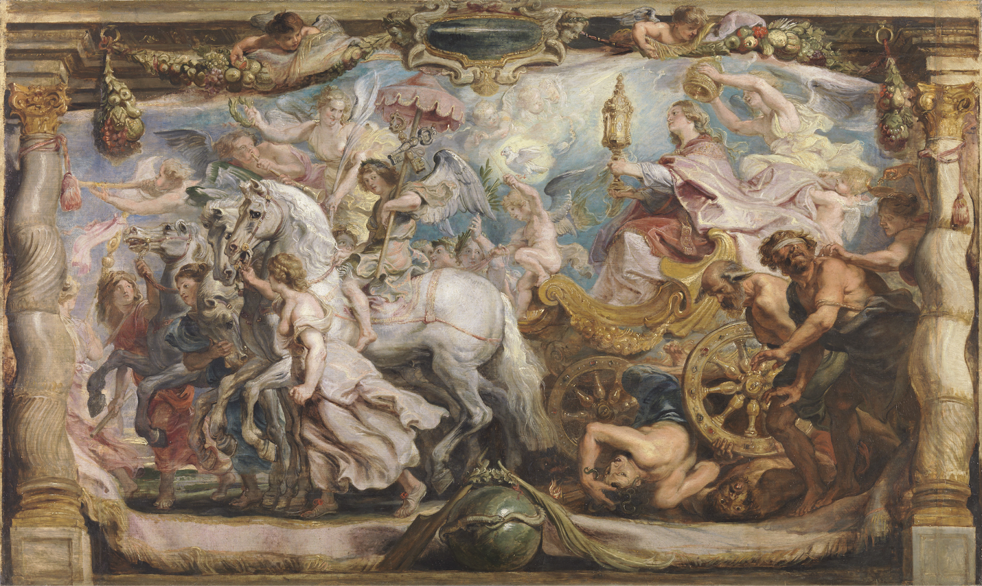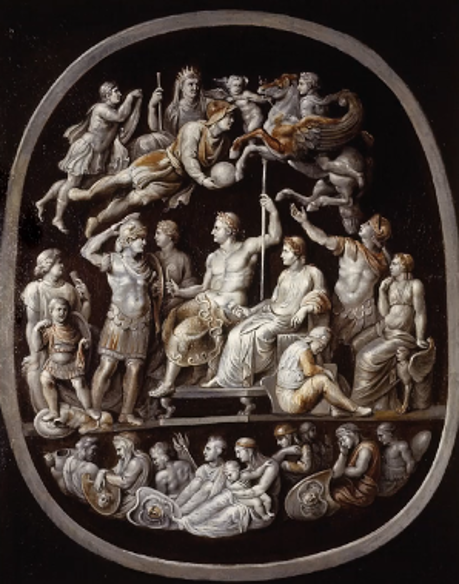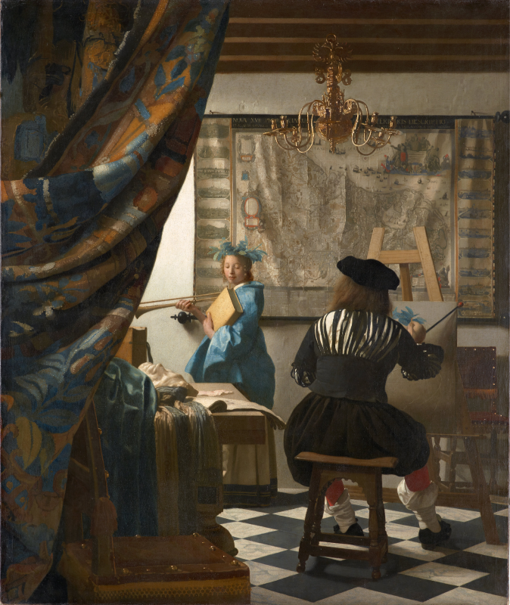Lecture 5: Classic Baroque: Painting Myths and the Myth of Painting
1/10
There's no tags or description
Looks like no tags are added yet.
Name | Mastery | Learn | Test | Matching | Spaced |
|---|
No study sessions yet.
11 Terms
Key Ideas (2)
The Baroque period is usually assumed to be after/opposed to the Renaissance & its peak of interest in antiquity
BUT Baroque artists continued to absorb & reinterpret the classical tradition
Peter Paul Rubens
Background
From Antwerp (present-day Belgium) (1577)
Took on the trappings of a gentleman; patrons were the courtly, primarily catholic elite; was knighted in England & Spain
Was highly receptive to antiquity
Received a classical education in Antwerp; was admired for his knowledge of antiquity
Later in life, had an impressive collection of antiquities, ancient texts & modern commentaries (text-based classical tradition)
‘In order to attain the highest perfection in painting, it is necessary to understand the antique, nay, to be so thoroughly possessed of this knowledge that it may diffuse itself everywhere.’
Travelled to Italy in 1600 (later than many of his compatriots)
Stayed for 8 years
Spent much time at the North Italian court of the Gonzaga family in Mantua
Impact of the classical on his works
After his return from Italy:
Sought to bring a little bit of Italy back home w/ him to Antwerp
E.g. his Antwerp mansion: added Italianate structures to his new home
Classicising arch leading into the garden, façade decorated w/ classicizing reliefs & art based on well-known classical reliefs Rubens had copied in Italy
Housed his classical collections of art & literature
Continued to refer to his drawings for inspiration
BUT NOT just blindly imitative; still contains his unmistakable hand
Was criticized by some competitors for borrowing whole figures from the Italians
Rubens: his competitors were free to do so likewise, if they found that they could benefit from it
= suggested that there was more to his borrowings than merely making whole copies; rethinking classical models required special skill
Continued to refer to ancient texts for inspiration
Made paintings depicting narratives from ancient texts
E.g. The Apotheosis of Germanicus (Gemma Tiberiana) (1626), Peter Paul Rubens)
Svetlana Alpers: this interest in using art to illustrate texts was a key feature of the Renaissance = Rubens was, despite being from the North, an Italianate artist ⭐
Artistic philosophy
Art should imaginatively evoke what is in our minds & in the books we have read
Seeks to merge text & image into a seamless & convincing unity
His unquestioning iconographic & formal hierarchies prioritise the classical tradition above all else
Jan Vermeer
Background
(Non) impact of the classical on his works
Background
Was born & spent much of his working life in Delft (a city in the Netherlands) (1632)
Patrons were wealthy, mostly Protestant citizens of his hometown
(Non) impact of the classical on his works
Early works: explicitly Christian & classical narratives
Majority of works: interior scenes
E.g. The Art of Painting (ca. 1666–1668), Johannes Vermeer
Women (& occasionally men) absorbed by the minutiae of everyday life
Surrounded by objects & spaces that are intimately observed
Possibly used a camera obscura to make them: a highly effective means of tracing, painting, & mapping the world in 2 dimensions
Svetlana Alpers: Vermeer stands IN OPPOSITION TO the text-based classical tradition associated w/ Rubens
‘Anti-narrative’ & ‘anti-classical’ ⭐
Many scholars have tried to find specific texts to explain supposedly hidden allegorical/narrative meanings of Vermeer’s scenes
BUT Alpers argues we must try to see these images w/o any Italianate preconceptions (concerned w/ illustrating a classical text/narrative; action & visual narration)
Instead, Vermeer has a profoundly Northern interest in ‘describing the world’ (mapping impulse & describing the present day w/ a highly attentive eye)
Artistic philosophy
Art can only describe what the artist actually sees before his eyes
Refuses to merge text & image into a seamless & convincing unity
Diego Velázquez
Background
Engagements w/ the classical/Renaissance (2)
Oeuvre (4)
Artistic Philosophy
Background
Born in Spain (1599)
In his 20s: moved to the Spanish & Catholic court of Philip IV in Madrid
Engagements w/ the classical/Renaissance:
Gained access to the King’s art collection (incl. numerous paintings by Titian)
Met Rubens when the latter spent a year at the Spanish court in the late 1620s
Later, made 2 trips to Italy to:
(1) Buy more paintings for the royal collection
(2) To study Italian masters & ancient artefacts in person
Oeuvre:
(a) A small no. of religious paintings
Most w/ a Counter-Reformation, Catholic agenda
(b) A small no. of genre paintings
Domestic subjects
Pays descriptive attention to surface textures & individual objects; similar to Vermeer
(c) A small no. of narrative/text-based paintings
E.g. Apollo in the Forge of Vulcan (1630), Diego Velázquez
E.g. The Myth of Arachne/The Spinners (ca. 1657), Diego Velázquez
BUT unlike Rubens & Vermeer, his works lie between the narrative & descriptive modes
(d) Most commonly, painted portraits of the royal family, courtiers, etc.
E.g. Las Meninas/The Family of Philip IV (ca. 1656), Diego Velázquez
Artistic philosophy
Intentionally ambiguous response to his classical & classicising predecessors
Diego Velázquez vs. Peter Paul Rubens vs. Jan Vermeer


The Triumph of the Catholic Church (ca. 1625), Peter Paul Rubens
Historical context
Preparatory oil sketches for a tapestry series
Commissioned for a Franciscan convent in Madrid by Isabella Clara Eugenia
One of Rubens’s most important patrons
A Spanish Habsburg (devout Catholic ruler of the Spanish Netherlands)
Herself was a lay member of the convent
Analysis
Mantegna’s classicising composition, The Triumphs of Caesar (at Hampton Court Palace, London)
Classical imagery
E.g. classicised, twisted columns
E.g. the triumphant Church is depicted as an allegorical female figure, reminiscent of classical personifications of victory
E.g. mythological figure, idealized & classicized bodies, nudity
Interpretation
Classicising imagery to serve a non-classical theme: the allegorical triumph of the Catholic church
To serve his patron’s devotional & political interests
Support for the Counter-Reformation (the Catholic church’s attempts to counter the criticism of it by Protestant reformers)
Through carefully-controlled but often highly-emotional forms of visual imagery

The Apotheosis of Germanicus (Gemma Tiberiana) (1626), Peter Paul Rubens
Historical context
Exemplifies Rubens’s interest in collecting classical coins (esp. cameos & gems)
Rubens’s correspondence w/ his friend Nicolas-Claude Fabri de Peirsec
Peirsec had established that a famous ancient cameo was actually a depiction of the apotheosis of the Germanicus
Thought in medieval times to be an illustration of the Old Testament tale of Joseph @ the court of the Egyptian Pharaoh
Peirsec reunited a classical image w/ its correct classical iconography (matching image → text)
Seen as a key characteristic of the Renaissance revival of the classical tradition
Excited by such discoveries, Peirsec & Rubens planned an illustrated volume showing all the most beautiful ancient cameos & gems known at the time
Project was never completed
BUT Rubens painted an enlarged copy of the cameo as a gift for Peirsec
Description
Depicts Germanicus taking leave of his parents, the Emperor Tiberius and his mother Livia
With other members of the Julio-Claudian family, past and present.
Analysis
Exaggerated classicising aspects of the original cameo
E.g. classicized bodies: modelled figures to emphasise musculature, volume & contours; idealized
E.g. heightened shadows, even behind the figures = more animated, lifelike
E.g. intensified expressions of the figures
Endowed w/ a graceful naturalism
E.g. added a life-like warmth to the white, cold stone
Did not replicate the layers of brown in the sardonyx
Instead, subtler and more blended brown
E.g. tidied up the cameo’s irregular shape & restored 2 heads in the bottom left & right, which were missing in the original
= an attempt to perfect it
Interpretation
His copy was NOT a documentary record, but a sympathetic interpretation ⭐of the stately classical beauty of the gem.

The Art of Painting (ca. 1666–1668), Johannes Vermeer
Description
The artist himself is sat painting
Dressed in what would have seemed at the time a rather old-fashioned outfit in the Burgundian style
Has begun to paint the woman standing before him on his canvas
The woman represents a figure of Clio
The ancient muse of History
Holds a book, a trumpet, & wears a crown of laurels
BUT clearly is not supposed to be Clio herself, but one of Vermeer’s models dressed up & posing as Clio
A map of Holland hanging on the wall
Upper right edge of the map: the word ‘descriptio’ (= description)
As if to confirm the essentially descriptive nature of Vermeer’s project ⭐
Interpretation
Rather than depicting the actual classical figure of Clio, Vermeer shows a 17th-century woman pretending to be a classical muse
REFUSES to merge text & image into a seamless & convincing unity (vs. Rubens)
Shows us how artificial it can be to do so
Lays bare before our eyes the mechanics of pictorial representation
The process by which a model is transformed → myth
Art can only describe what the artist actually sees before his eyes ⭐
Highlights tensions between:
Description vs. narration
Mapping the world vs. illustrating a text

Apollo in the Forge of Vulcan (1630), Diego Velázquez
Description
Shows the moment when the god Apollo (far left) announces to Vulcan (in the centre) that his wife Venus is having an affair w/ the god Mars
Interpretation
At 1st glance, seems to be a typically Italianate illustration of a classical text (Ovid’s Metamorphoses - Roman mythology)
BUT:
Attention to detail; meticulous depiction of objects (e.g. Vulcan’s tools & the red-hot piece of armour he’s about to hammer)
Using real, manual labourers for his figures RATHER THAN idealised male bodies based on ancient sculptural prototypes
= makes this work lie BETWEEN the narrative & descriptive modes identified by Alpers

Las Meninas/The Family of Philip IV (ca. 1656), Diego Velázquez
‘Las Meninas’ = the maidservants
Description
A room in the Spanish royal palace
Velázquez himself stands on the left
In front of an enormous canvas, which we cannot see
1 of the royal princesses posing beside him
Attended by 2 maidservants, a dog, and 2 court dwarfs
Behind, other courtiers come & go
Background: dark, shadowy paintings hanging on the rear wall
All copies of works by Rubens depicting mythological tales from Ovid
In the style of Titian
= alludes to his fellow classicising & text-oriented artists
The King & Queen are included indirectly in the shiny, light-filled frame in the back
Depicts a mirror rather than another painting
The mirror as a long-standing symbol of mimesis
= everyone in the painting looks out attentively towards the viewer because the people standing in this position are the King & Queen of Spain
OR the mirror reflects the painted portraits of the royal couple painted on the unseen canvas
Interpretation
Italianate vision of the intellectual & social ambitions of artists & art itself ⭐
Makes grandiose claims about his own status as an artist
E.g. portrays himself as a well-dressed gentleman
E.g. includes the red cross of the Knights of Santiago on his suit
An aristocratic order that he would eventually join
E.g. clearly at ease w/ the servants, courtiers, and the royal princess herself
= visual confirmation of his social graces & status at court
Wilful visual ambiguity about royal couple in the mirror
Highlights the artist’s intelligence & skill
= supports his claims about the status of artists & the art of painting itself
Vs. Rubens & Titian had both been knighted
Velázquez was only just putting together a petition to ask for a knighthood of his own
BUT does this through a visual description of the here & now
DESPITE alluding to his classicising & text-oriented fellow artists
Velázquez’s own painting seems much more descriptive > narrative
A snapshot of a fleeting moment in the everyday domestic life of the royal family
Rather than an idealised & imagined reconstruction of a distant & ancient past
= Velázquez stands WITHIN & OUTSIDE the classical Italianate tradition ⭐
The Myth of Arachne/The Spinners (ca. 1657), Diego Velázquez
Historical context
Textual source for the scene in the background: Ovid’s Tale of Arachne
Ancient Roman poetry
A highly-gifted weaver who foolishly challenges the goddess Minerva to a contest to see who could produce the best tapestry
Arachne’s hubris leads to her downfall
The goddess turns her into a spider
The moment depicted is just before her downfall
Description
Foreground: people spinning threads used to make tapestries
Background: Arachne showing off her handiwork to Minerva
Minerva w/ her armour & helmet
Arachne’s tapestry evokes Titian’s famous painting of yet another classical story: the Abduction of Europa
Also written by Ovid
This painting was owned at the time by Philip IV
= provided Velázquez w/ a painterly model @ 1st hand
Interpretation
Velázquez’s homage to classical literature & the classicising art of Titian ALSO includes some very Northern features
E.g. mythological tales (main narrative action) confined to the background, while foreground depicts a more typically-Northern genre scene of everyday life ⭐
This composition comes from Northern sources